This post is to document a technique (or the realization of the lack of it, rather) that became apparent to me while I was making the bread below (the first one). I subsequently applied it in making the second bread below with good result and would like to share my experience.
It started because I wanted to re-do my last try at Chad Robertson's French-style Country Sourdough back in September. This was one of my New Year bread Resolutions. My Imitation of Chad Robertson's Country Sourdough had a serious flaw: sourdough without whole wheat flour and/or rye flour can hardly be called Country Sourdough (Pain de Campagne). Very soon after I did that post, it was clear to me that the ratios that I used in my formula with regards to ingredients were nowhere near those used by Chad Robertson; for instance, starter as a percentage of final dough flour, starter hydration and overall dough hydration ratios, etc. My timeline may be quite accurate as it was pieced together from "A Day in the Life at the Bay Village Bakery" in The Bread Builders by Daniel Wing and Alan Scott who interviewed Chad.
I reconstructed my formula as follows:
- 450 g ripe 75%-hydration starter (after a special 2-hour levain expansion), 100% baker's percentage
- 70 g organic stone-ground medium rye flour (10% of total flour)
- 140 g organic stone-ground whole wheat flour (20% of total flour)
- 240 g organic unbleached plain flour
- 316 g water
- 14 g salt
Total dough weight was 1,230 g and the overall hydration was 72%.
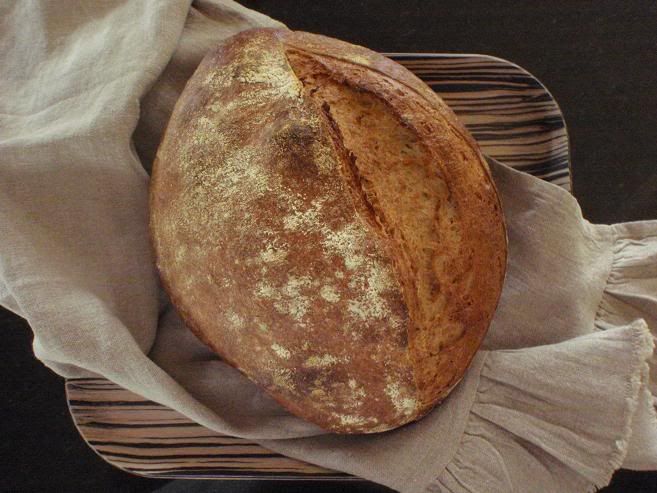
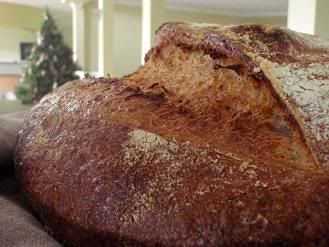
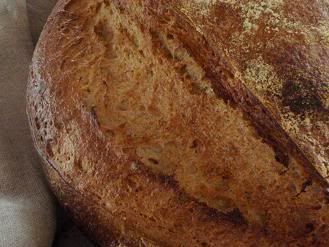
The bread looked gorgeous from the outside. That was only half of the story. The crumb revealed the other half of the story:
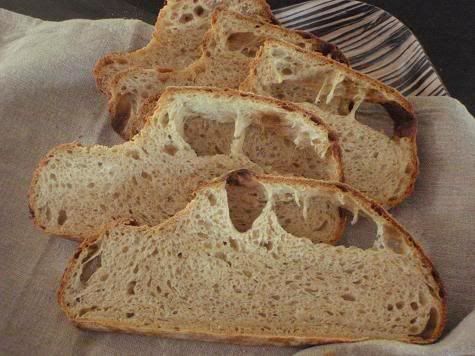
London cabs?
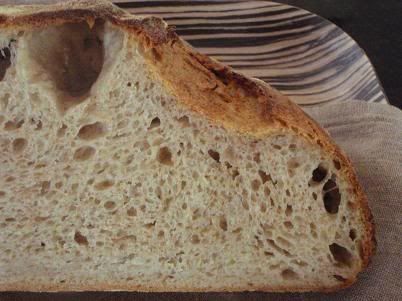
THAT hole was where my thumb was (see point (2) below)
While the crumb was lovely to taste, springy to bite, and not altogether dense, I did not develop the full potential of the crumb as would otherwise be manifested in the open cell structure. I knew this because of what I was able to achieve in my last Chad Robertson bread, using similar formula. I looked back at what I had done differently, and I think the following was what happened:
(1) That my starter was over-ripe before I did the two-hour expansion and, despite the two-hour expansion, my starter was still "tired." My starter was not at its most vigorous when I used it to mix the final dough. And,
(2) That my stretch and folds could have been better executed. (I used my left hand to hold and stabilize the dough while my right hand folded it. As the dough was folded onto itself, my left thumb was in the way because I did the S&F's in a very quick motion as if I was in a hurry or racing to get the job done. The big hole in the crumb shot above was the mark that my left thumb had left behind.) The point here, however, is not about the hole so big that a mouse could sneak through. The point here is that I was stretching and folding the dough too fast that the dough was not allowed an optimal chance for proper gluten development while the fermentation was happening concurrently.
I came across the following remark in LeadDog's comment in a post, entitled "Exploring Bread" in Sourdough Companion that best exemplifies what I meant. He said,
When I was reading "Local Bread" Leader attributed the following concept to Max Poilane:
"Max explained how slow, steady kneading gently conditions the gluten to create an extensible and elastic dough. The modern practice of high-speed mixing while hurrying along the process, oxygenates the dough too much and bleaches it out, causing the bread to lose flavor and character."
In my formula above, there are at least two more elements that are not consistent with a French-style Country Sourdough. And these are (a) that the levain is normally a stiff levain, and (b) that the levain normally falls within 25 to 35% of baker's percentage.
Based on the foregoing, I gave it one more try at reproducing Chad Robertson's Country Sourdough that I had when I visited his Tartine Bakery last August in San Francisco.
My formula for Bread Inspired by Chad Robertson's Country Sourdough
- 150 g just ripe stiff levain @60% hydration (30% baker's percentage)
- 41 g organic stone-ground medium rye flour (7% of total flour)
- 82 g organic stone-ground whole wheat flour (14% of total flour)
- 377 g organic unbleached plain flour
- 384 g water
- 11 g salt
Total dough weight was 1040 grams and overall hydration was 74%.
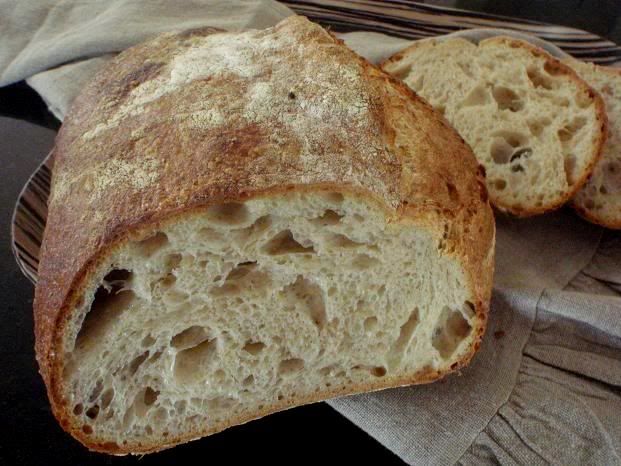
Some main points of my procedure
My room temperature was 28C. Over the three hours of bulk fermentation (from the time mixing was complete to the time I pre-shaped the dough), I did 4 sets of slow and gentle S&F's of 25 strokes each, every 45 minutes or so apart.
At the end of each set of S&F's, instead of oiling a separate clean bowl to place the dough in, which I find really troublesome, I dab some oil at the edge of the dough where it meets the mixing bowl all round. This works really well - the oil protects the dough from tearing through the successive S&F's. I also oil my fingers so the dough doesn't stick to my fingers. I have a standing plastic container on the side, in which I have oil, ready to be used.
I proved my shaped dough for about an hour and then placed it in the refrigerator for a 12 hours retarding.
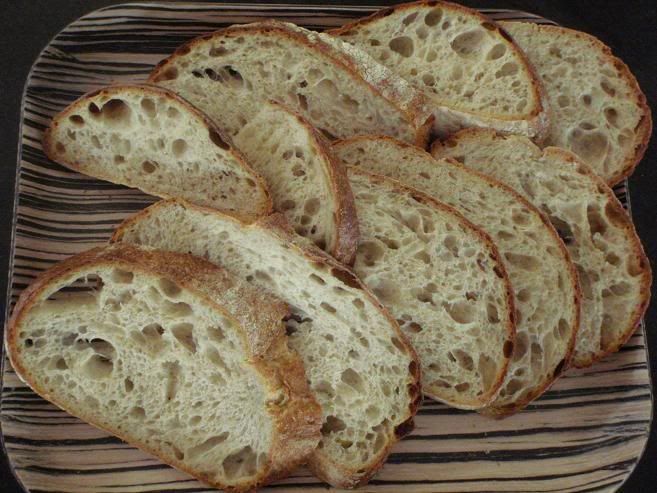
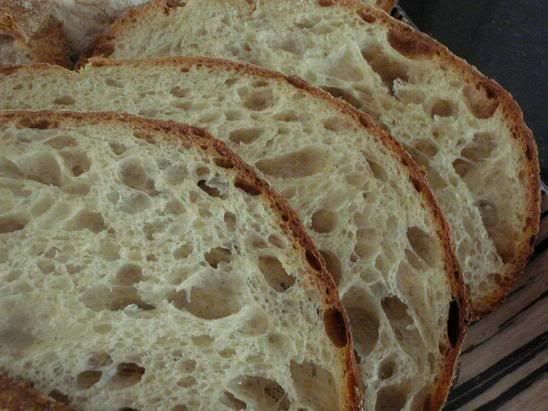
I am very happy with the result and will now close my book on Chad Robertson's country sourdough. If you are interested to try this recipe, the two-hour levain expansion is not necessary, but just make sure that your starter is very vigorous; under ripe, I think, is better than over-ripe; I would use it as soon as it domes.
The recipe looks simple. Its success, however, is all in the understanding of and management of the fermentation and gluten development processes simultaneously. They are independent of each other and yet co-dependent on each other.
This is the first time that I felt that our dough should be treated with love. "Slow and gentle S&F's" means love.
In closing, may I be presumptuous and say that I would like to bring your attention to a most beautifully written "Meet the baker" story by MC. So much love came out of her description of Gérard Rubaud, the man, the baker, and his way of making his Pain au Levain. If you can feel the love, your Pain au Levain will have come to a new level.
Shiao-Ping